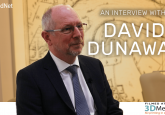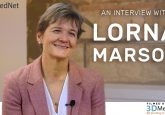Adopting innovative technologies into UK health systems
In this interview, Michael Branagan-Harris, CEO of Device Access UK Ltd (Southampton, UK), discusses the process and key challenges of adopting a novel medical device into the NHS (UK), highlighting the key considerations and his top tips for companies introducing a novel device into medical systems.
Register as a member of 3DMedNet for exclusive 3DMedLIVE content
Biography

Since 1989, Michael Branagan-Harris, CEO of Device Access UK Ltd (Southampton, UK) has been involved in accelerating patient access to great technology in the UK’s health care system – the National Health Service (NHS),
During his role in sales, he introduced the Lap Band for obesity, endovascular grafts, novel endo laparoscopic surgery devices and the DaVinci robot.
From 2006–2009 Branagan-Harris ran VNUS Medical UK Ltd (Southampton, UK), a subsidiary of VNUS Inc San Jose California, (CA, USA), where he introduced VNUS Closure®, a novel minimally invasive treatment alternative to painful vein stripping surgery. Following his team’s efforts, VNUS Closure was showcased by The NHS Innovation Centre, leading to accelerated adoption and diffusion across the NHS and VNUS Medical was subsequently purchased by Covidien (Dublin, Republic of Ireland) for over US$500M. Today VNUS Closure has fully replaced traditional vein stripping surgery as the procedure of choice, saving the NHS over 50,000 valuable bed days a year.
Michael incorporated Device Access UK 9 years ago and since then his team has helped hundreds of medical device and diagnostic companies navigate their way into the NHS. Their clients range from small start-up to multinational from across the world.
Device Access was granted a commercial license from NHS Digital to access over 900+million pseudonymized patient health ‘claims data’ records. This data allows them to examine diagnosis, procedure and spend data, nationally and by each NHS hospital in England, and in turn enables Device Access to see how their client’s technology could affect the current patient pathway, assist in building a value story with NICE and a solid business case for local and national NHS Hospital adoption.
In 2018 Device Access relocated to the University of Southampton Science Park, and today the team consists of specialists in NHS change management and dossier writing, real world data analytics, health economics and outcomes research, publication of economic evidence and supporting clients for NICE HTA approvals. This work also involves close collaboration with the National Office for Clinical Research Infrastructure (NOCRI), the National Institute for Health Research (NIHR) and the UK’s Department of international Trade (DIT).
To date, Device Access has helped over 30 companies navigate various NICE evaluation programs for approval. More recently in March 2019 Device Access became part of the IGES Group of companies – www.iges.com
“I would hope in 5–10 years’ time, companies will produce technologies that will reduce length of stay, reduce complications and help hospitals to be more productive, but most of all, improve patients’ lives and recovery from surgery.”
Branagan-Harris was interviewed at 3DMedLIVE 2019: 3D printing in surgery. To access more exclusive interviews and content from 3DMedLIVE 2019, watch this space on 3DMedNet >>
>> Find out more about 3DMedLIVE
Interview segments:
- Introduction [00:03]
- Introducing 3D printing into the medical industry [00:33]
- Challenges facing companies introducing innovative technologies into medical systems
- Advice for companies introducing novel technologies into medical systems [02:14]
- 3D printing in medicine in 5–10 years’ time
You may also be interested in:
- 3D printing in the medical field: the concept, the benefits and the future
- A snapshot interview: integrating 3D printing into surgical workflows with Paul Unwin
- Interdisciplinary approaches to surgery: 3D printing at Mayo Clinic with Amy Alexander
- Clinical engineering and innovative technologies for surgery with Giuseppe Isu
The opinions expressed in this feature are those of the interviewee and do not necessarily reflect the views of 3DMedNet or Future Science Group.





